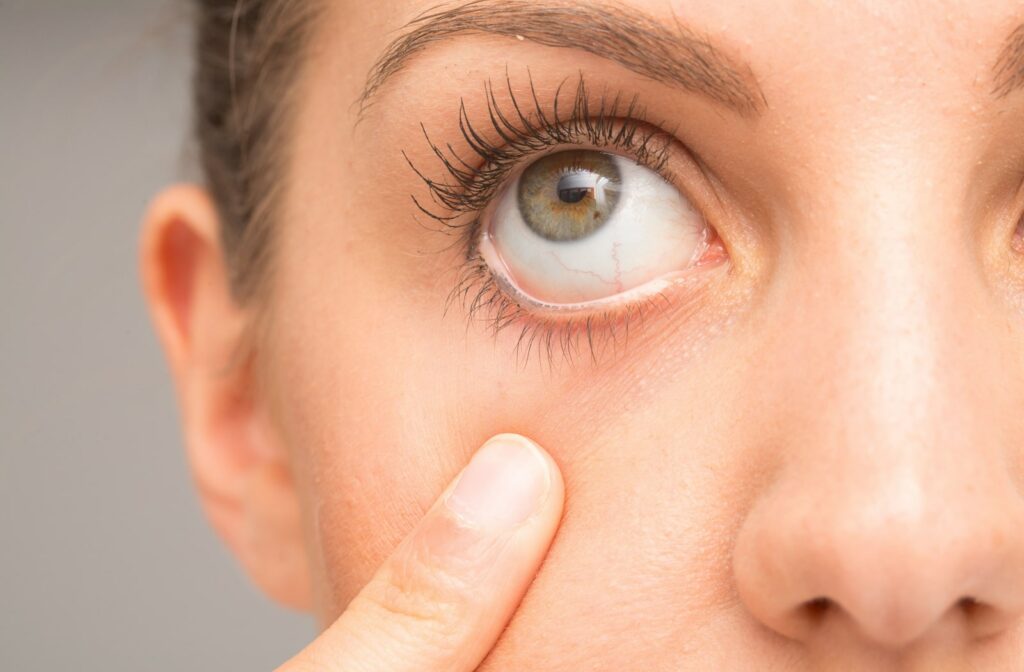The meibomian glands play a pivotal role in maintaining your eye health. These tiny glands that line the eyelids are essential for keeping our eyes moist and comfortable. But what happens when they falter?
Meibomian gland dysfunction (MGD) is a common condition that occurs when the meibomian glands become inflamed, blocked, or disrupted.
MGD can cause uncomfortable dry eye symptoms, but we can offer solutions during a comprehensive eye exam.
Understanding MGD
MGD occurs when the meibomian glands, responsible for secreting oils (meibum) that prevent the evaporation of the tear film, become dysfunctional.
This dysfunction leads to a decrease in the quality and quantity of the tear film’s oily layer, resulting in increased evaporation of the tears and subsequent dryness on the ocular surface. Without proper lubrication, the eyes can become uncomfortable, red, irritated, and gritty, impacting your vision.
Common Symptoms of MGD
MGD often causes a range of uncomfortable symptoms, including:
- A persistent feeling of grittiness or as if something is in the eye.
- Redness or irritation.
- Burning or stinging, accompanied by excessive tearing.
- Blurry vision, primarily upon waking.
- Challenges wearing contact lenses comfortably.
What Are the Risk Factors for MGD?
There are a few factors that can increase your chances of developing MGD:
- Getting older
- A lack of certain hormones, like androgen
- A tendency toward allergic reactions
- Contact lens use
- Immune system disorders, like rosacea, Sjögren’s syndrome, lupus, psoriasis, or rheumatoid arthritis
- Other conditions, like high blood pressure and cholesterol or chronic eye infections
Diagnosis & Treatment
Diagnosis typically begins with a comprehensive evaluation by your eye doctor. They can use specialized instruments and techniques to assess gland function and the quality of the meibum produced.
Your plan may include steps you can take at home or in-office treatments.
At-Home Steps
- Use a warm compress at home to help liquefy and release the oily secretions.
- Maintain a more thorough eyelid hygiene routine to help prevent blockages.
- Take medications to help manage inflammation and encourage proper gland function.
- Maintain a healthy lifestyle by staying hydrated and consuming a balanced diet rich in omega-3s, such as fish or flaxseed oil.
- Schedule regular eye exams to catch signs of MGD early and effectively manage symptoms.
In-Office Procedures
Several in-office treatments are available to not only improve your symptoms but also address the root cause of your condition. We offer:
- Autologous serum (ASEDs) and platelet-rich plasma (PRP) eye drops: ASEDs and PRP drops are custom-made from your blood and may provide better relief from symptoms for some patients. Higgins Brothers’ Vision Care is the only optometrist in Connecticut that offers this treatment!
- Lipiflow: This treatment uses small activators that connect to your eyelids, delivering gentle pulsating heat to your meibomian glands that loosen blockages.
- Equinox LLLT: This device uses a wearable attachment that emits gentle light to warm your meibomian glands to help melt away and loosen blockages.
- Lumenis OptiLIGHT: This treatment gently heats the meibomian glands using precise light pulses to help loosen blockages along the eyelid margin.
- NuEra: This treatment uses radiofrequency (RF) energy that penetrates deep into the eyelid tissues. It helps restore the natural balance of oils by releasing clogged oil and targeting inflammation that worsens dry eye symptoms.
- Meibomian gland expression: This procedure helps clear blockages in your meibomian glands using gentle massage.
- Blepharoexfoliation: This treatment is a process that cleans dirt, debris, bacteria, and other blockages from your eyelids. It can help manage MGD and blepharitis.
- Intraductal probing: This procedure involves applying gentle pressure to the eyelids to help express and clear the blocked meibomian glands.
Move Forward with More Confidence
With proper care and attention to your eye health, MGD can be managed effectively. Establishing a routine with regular visits to your eye care provider, like Higgins Brothers’ Vision Care, can help.
Our friendly, educated staff will work hard to make sure you receive knowledgeable guidance on managing MGD. Reach out to us today!




